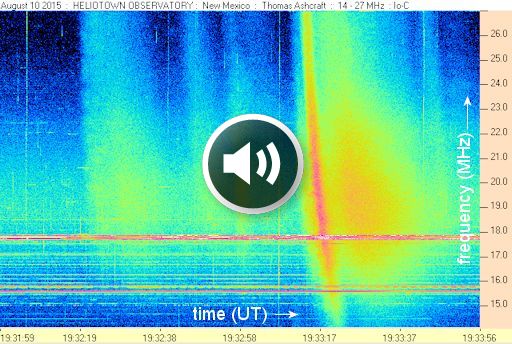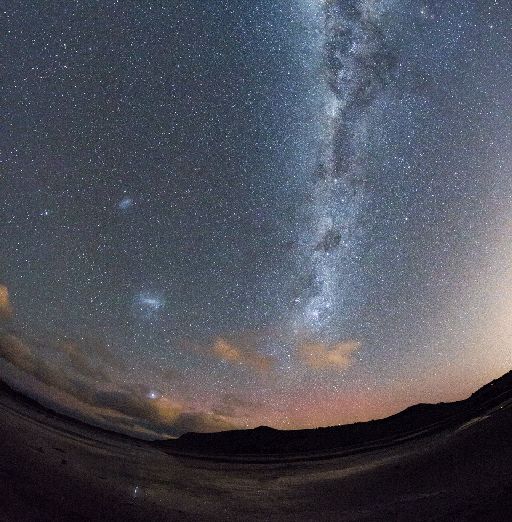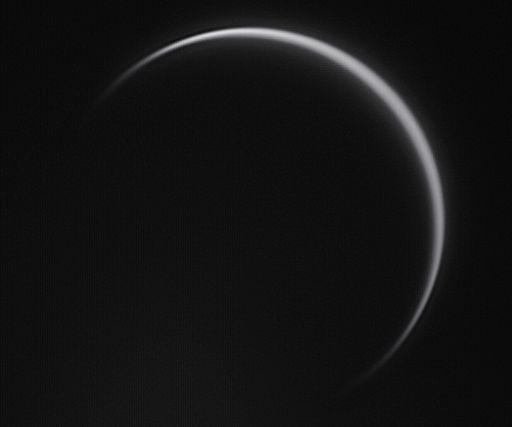Learn to photograph Northern Lights like a pro. Sign up for Peter Rosen's Aurora Photo Courses in Abisko National Park, winner of the TripAdvisor Certificate of Excellence Award 2015. | | |
PERSEID METEOR SHOWER--THIS WEEK: Earth is entering a stream of debris from Comet Swift-Tuttle, source of the annual Perseid meteor shower. Forecasters expect meteor rates to peak at 100+ per hour on the night of Aug. 12-13 when our planet passes through the heart of the debris stream. Perseids produce more fireballs than any other meteor shower of the year, so stay tuned for a good show. [meteor radar]
SOLAR RADIO BURSTS: For the past week, solar activity has been low. However, the sun has not been quiet. "I have noted that the sun has been extremely dynamic at shortwave radio wavelengths with almost constant Type III bursting," reports Thomas Ashcraft of New Mexico. He has been hearing loud bursts of static coming from the loudspeaker of his amateur radio telescope whenever he points it at the sun. Click on the dynamic spectrum below to hear a sample:

Type III solar radio bursts are caused by solar flares. Electrons accelerated by strong flares race through the sun's atmosphere, causing a ripple of plasma waves and radio static. Yet, ironically, there have been no strong solar flares. Nevertheless, suggests Ashcraft, "all of the bursting indicates a lot of magnetic complexity and movement in the sunspots."
The biggest sunspot of all, AR2396, is about to rotate off the western edge of the sun. After it departs, the static might subside. Until then, shortwave radio operators should remain alert for solar bursts. The sun is not so quiet, after all.
Realtime Space Weather Photo Gallery
DEEP-SKY AURORAS: For the 4th day in a row, Earth is inside a gently undulating stream of fast-moving solar wind. The encounter has not sparked any geomagnetic storms, but there is a gentle glow of auroral light ringing the poles. Last night (Aug. 10th), Ian Griffin captured the phenomenon over Hooper's Inlet in the Otago Peninsula of New Zealand:

"A lovely calm night in Hooper's Inlet made for some magnificent photographs of this evening's beautiful and subtle display of the Aurora Australis," says Griffin.
The red glow was not visible to the naked eye, but Griffin's deep exposure of the Milky Way revealed the auroras as well. An even more dramatic example of such "deep sky auroras" was captured over Canada.
More displays of this type may be in the offing. Earth is expected to spend at least one more day inside the solar wind stream, then its effect will wane as the week unfolds. Aurora alerts: text or voice.
Realtime Venus Photo Gallery
A SLIVER OF VENUS: On August 15th, Venus will pass almost directly between Earth and the sun--an event astronomers call "inferior solar conjunction." As Venus approaches the sun, the planet is turning its night side toward Earth, reducing its luminous glow to a thin sliver. Damian Peach sends this image of the narrowing crescent from his private observatory in Selsey, UK:

In the days ahead, the crescent of Venus will become increasingly thin and circular. The horns of the crescent might actually touch when the Venus-sun angle is least on August 15th (7.9o). This is arguably the most beautiful time to observe Venus--but also the most perilous. The glare of the nearby sun magnified by a telescope can damage the eyes of anyone looking through the eyepiece.
Anthony J. Cook of the Griffith Observatory has some advice for observers: "I have observed Venus at conjunction, but only from within the shadow of a building, or by adding a mask to the front end of the telescope to fully shadow the optics from direct sunlight. This is tricky with a refractor or a catadioptric, because the optics start at the front end of the tube. Here at Griffith Observatory, I rotate the telescope dome to make sure the lens of the telescope is shaded from direct sunlight, even through it means that the lens will be partially blocked when aimed at Venus. With our Newtonian telescope, I add a curved cardboard mask at the front end of the tube to shadow the primary mirror."
Potential observers should take precautions as outlined above. That said, if you have a GOTO telescope, command it to slew to Venus this evening. The slender cresent is only 12o from the sun on Aug. 8th, and it's a beauty!
Realtime Venus Photo Gallery
Realtime Aurora Photo Gallery
Realtime Sprite Photo Gallery
Realtime NLC Photo Gallery
Every night, a network of NASA all-sky cameras scans the skies above the United States for meteoritic fireballs. Automated software maintained by NASA's Meteoroid Environment Office calculates their orbits, velocity, penetration depth in Earth's atmosphere and many other characteristics. Daily results are presented here on Spaceweather.com.
On Aug. 11, 2015, the network reported 86 fireballs.
(46 sporadics, 38 Perseids, 1 Northern delta Aquariid, 1)

In this diagram of the inner solar system, all of the fireball orbits intersect at a single point--Earth. The orbits are color-coded by velocity, from slow (red) to fast (blue). [Larger image] [movies]
Potentially Hazardous Asteroids (
PHAs) are space rocks larger than approximately 100m that can come closer to Earth than 0.05 AU. None of the known PHAs is on a collision course with our planet, although astronomers are finding
new ones all the time.
On August 11, 2015 there were 1603 potentially hazardous asteroids.
Notes: LD means "Lunar Distance." 1 LD = 384,401 km, the distance between Earth and the Moon. 1 LD also equals 0.00256 AU. MAG is the visual magnitude of the asteroid on the date of closest approach. | | The official U.S. government space weather bureau |
| | The first place to look for information about sundogs, pillars, rainbows and related phenomena. |
| | Researchers call it a "Hubble for the sun." SDO is the most advanced solar observatory ever. |
| | 3D views of the sun from NASA's Solar and Terrestrial Relations Observatory |
| | Realtime and archival images of the Sun from SOHO. |
| | from the NOAA Space Environment Center |
| | the underlying science of space weather |
| | Web-based high school science course with free enrollment |

